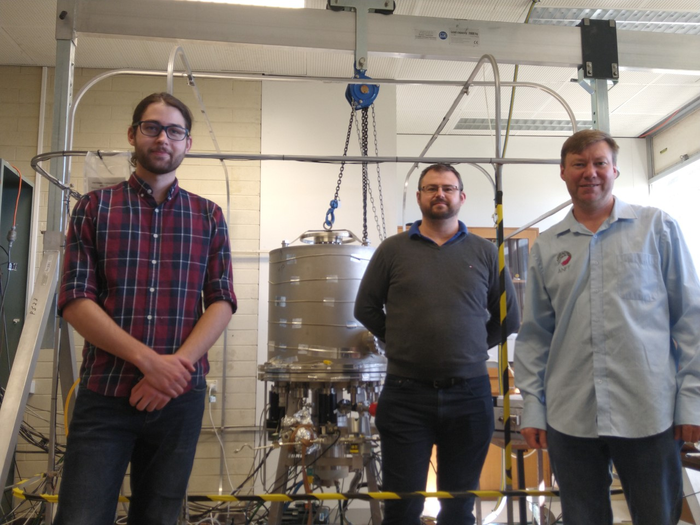Reviewed by Alex SmithApr 6 2022
Instant wound healing has been a show-stealer in numerous science-fiction and fantasy films, from Star Trek to Wolverine and Dune.
 Visiting Ph.D. researcher Dale Maccignat with Dr. Darryl Jones and Dr. Jason Gascooke at Flinders University. Image Credit: Flinders University.
Visiting Ph.D. researcher Dale Maccignat with Dr. Darryl Jones and Dr. Jason Gascooke at Flinders University. Image Credit: Flinders University.
While research suggests that plasma therapy is a novel technique to speed up healing or change or sterilize heat-sensitive tissue, the use of low-temperature plasmas has remained out of reach until now due to a lack of good prediction models.
To advance the situation, Australian and Asian researchers are working with a liquid micro-jet in a vacuum chamber lab at Flinders University, using a fundamentally new way to understand electron transport into and within liquids to improve plasma-liquid models.
Research teams from James Cook University, Flinders University, and the Australian National University in Canberra used a simulation of a new experimental method to evaluate accurate electron cross-sections in liquid using a micro-jet of water only 15 micrometers in diameter, according to a new paper published in the International Journal of Molecular Sciences.
Due to the high standards required in medical applications, developing our understanding of electron transport into and within liquids is critical for enhancing predictive power of plasma-liquid models.
Michael Brunger, Professor, College of Science & Engineering, Flinders University
Physicist Dale Muccignat, a Ph.D. candidate at James Cook University, utilized machine learning and a large amount of Monte Carlo training data to create this proof-of-concept model.
As part of his extended honors and Ph.D. studies at James Cook University, Mr. Muccignat constructed a Monte Carlo simulation of electron and positron transport via diverse media, which Mr. Muccignat is presently working on alongside specialists at Flinders University.
The method allowed us to reasonably predict individual and two simultaneous electron scattering cross-sections which lays the foundation for a prediction of full, self-consistent cross-section sets in future studies.
Dale Muccignat, PhD Candidate, Physics Researcher, College of Science & Engineering, James Cook University
Plasma is a cloud of high-energy charged particles, such as electrons, ions and neutral molecules, that exists as the fourth state of matter.
The interaction of low-temperature plasmas, such as those created with heavy constituents at room temperature while electrons have enough energy to drive reactions within a target, could lead to new technologies and applications in fields as diverse as medicine, nanomaterial synthesis and even environmental remediation.
Journal Reference:
Muccignat, D. L., et al. (2022) Simulating the Feasibility of Using Liquid Micro-Jets for Determining Electron–Liquid Scattering Cross-Sections. International Journal of Molecular Sciences. doi.org/10.3390/ijms23063354.